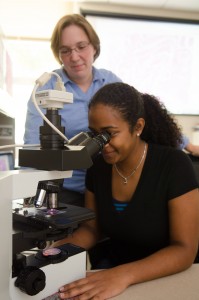 This is a brief overview of services offered by our laboratory. Please see accompanying fee schedule for current service rates.
This is a brief overview of services offered by our laboratory. Please see accompanying fee schedule for current service rates.
Tissues received in fixative will be manually trimmed by an ASCP-certified histotechnician to meet the size and orientation specifications required for processing and embedding. Clients have the option of performing this step prior to submission to reduce preparation fees. The Comparative Pathology Laboratory can provide training for proper sample trimming and orientation upon request (see fee schedule).
Trimmed specimens undergo overnight processing in a Leica processor to dehydrate the specimens in preparation for paraffin embedding.
Processed specimens are manually transferred from cassettes to metal wells and are embedded in paraffin wax at a Leica embedding center by the histotechnician to maintain proper specimen orientation for sectioning. Embedded specimens (“Blocks”) are complete at this step.
Paraffin blocks are affixed to a Leica microtome and typically cut to 4-6 micron thick sections. Sections are transferred from a water bath to a microscope slide for later staining and histopathologic analysis. Unstained slides are complete at this step.
Routine histopathologic analysis utilizes Hematoxylin and Eosin (H&E) staining applied by a Leica autostainer. Special stains, such as Gram, Periodic Acid Schiff (PAS), and other additional stains, are applied manually by the histotechnician. Contact the pathologist for special stain availability and cost. Stained slides are complete at this step.
Bone and other mineralized specimens require chemical decalcification prior to processing to soften tissues for sectioning. This additional step in specimen preparation creates a delay in processing of one or more days and can also create loss of detail in soft tissues and bone marrow which can interfere with microscopic analysis. Please contact the pathologist if this may be a concern in your study.
Digital slide scanning and virtual archives
Prepared glass slides are scanned by an Aperio AT2 ScanScope to create virtual slides which can be archived and analyzed indefinitely via Leica Biosystems' eSlide Manager and Image Analysis Toolbox. Virtual slides are viewable at all magnifications up to that of the objective (20x or 40x) under which scanning was performed. Archived specimens can be shared with collaborators at the client's discretion. Once scanned, remote viewing and analysis of archived slides are possible in real time at any location worldwide where internet services are available.
Histopathologic (Microscopic) Analysis and Reporting
Stained slides are analyzed by an ACVP-certified veterinary anatomic pathologist using one of the laboratory’s Leitz or Olympus light microscopes or through Aperio virtual microscopy. Results generated from the analysis are typically reported as a descriptive report and/or electronic spreadsheet. Reports provide a morphologic diagnosis, i.e. a concise technical description of the pathologic process occurring in the tissue, and/or a description of the lesions observed in the tissues on each slide. A summary of pertinent lesions by tissue or treatment group and clinical correlation of lesions observed to signs observed in the in the study is also provided when applicable. Final reports can be mailed or transmitted electronically by email based upon client preference.
High quality unaltered digital images of microscopic features of interest are captured by an ACVP-certified veterinary anatomic pathologist and provided in .tif or .jpg format based upon client preference and intended use. Images include descriptions and annotations prepared by the pathologist.
Laboratories utilizing the UD Comparative Pathology Laboratory have unique access to one-on-one or small group consultation and training by a board-certified veterinary anatomic pathologist and registered histotechnician prior to and during use of our services. Consultation and training topics include, but are not limited to: gross anatomy and lesion recognition; tissue collection, fixation, trimming and embedding; special stain options; microscopic analysis and experimental design. A brief consultation can be conducted at no charge prior to sample submission to determine individual client needs for services, training, or additional consultation. Sessions can be conducted by email, phone, or in person based upon client preference. Training sessions are held in our laboratory (for trimming and embedding) or in the client’s laboratory (for anatomic localization, lesion identification, and sample collection). Following training, clients may also elect to self-embed tissues using our equipment during normal business hours to reduce the cost of tissue preparation.

